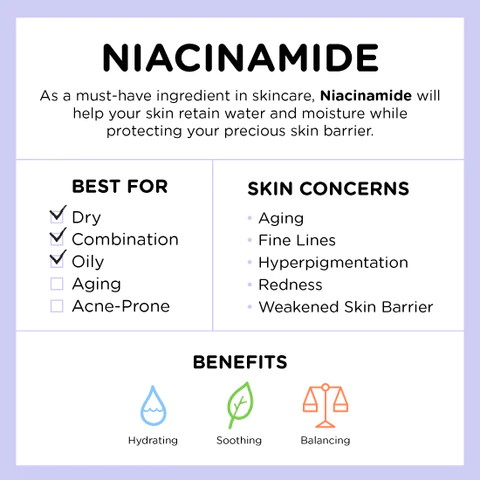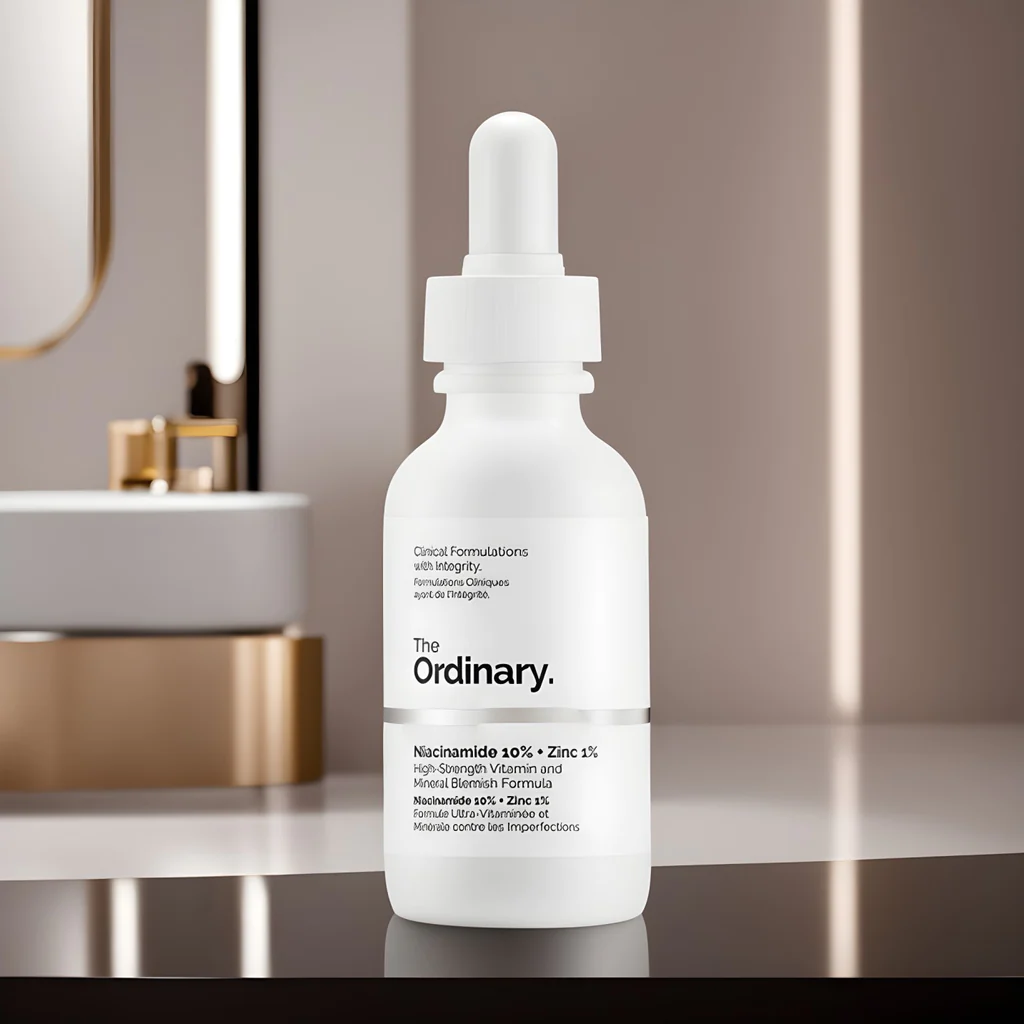Niacinamide, known as vitamin B3, has emerged as a skincare superstar, offering a plethora of benefits for maintaining and enhancing skin health. This water-soluble vitamin is celebrated for its versatility in addressing various skin concerns, from improving barrier function to brightening the complexion. In the realm of skincare, it is recognized for its ability to improve skin metabolism, protect against environmental damage, and synergize with other ingredients to maximize results. Let’s delve into the multifaceted world of niacinamide and uncover how it can transform your skincare routine.
Key Takeaways
- Niacinamide enhances the skin’s barrier function and moisture retention, thanks to its ability to stimulate ceramide production.
- It offers protection against photoaging by neutralizing free radicals and promoting collagen production for anti-aging effects.
- Niacinamide works well with other skincare ingredients like retinol and ceramides, offering synergistic benefits for improved skin health.
- Suitable for all skin types, niacinamide can address multiple concerns such as hyperpigmentation, enlarged pores, and inflammation.
- When incorporating niacinamide into your skincare routine, consider product concentration and ethical sourcing for sustainability.
Understanding Niacinamide and Its Skin Health Benefits

Role in Skin Metabolism and Cellular Turnover
Niacinamide plays a pivotal role in skin metabolism and cellular turnover, essential processes for maintaining a youthful and radiant complexion. It acts as a coenzyme in redox reactions, facilitating the transfer of electrons in metabolic processes. This activity helps in the renewal of skin cells, leading to a reduction in the appearance of fine lines and wrinkles over time.
Niacinamide’s involvement with sirtuins, proteins associated with longevity, further underscores its significance in skin health.
Additionally, Niacinamide contributes to the production of collagen, a vital protein for skin elasticity and firmness. Here’s how Niacinamide supports skin metabolism:
- Encourages skin cell renewal
- Contributes to collagen formation
- Supports the function of sirtuins
By enhancing these fundamental skin functions, Niacinamide ensures that the skin remains resilient and capable of repairing itself effectively.
Protection Against Photoaging and Environmental Damage
Niacinamide, a versatile skincare ingredient, offers significant protection against photoaging and environmental damage. This form of vitamin B3 has been shown to reduce the impact of harmful UV rays and pollution, which can lead to premature aging of the skin. By bolstering the skin’s defense mechanisms, niacinamide helps to maintain a healthier and more resilient complexion.
Niacinamide’s antioxidant properties play a crucial role in neutralizing free radicals, which are unstable molecules that can cause oxidative stress and damage to skin cells. This damage often manifests as fine lines, wrinkles, and a lossluster appearance.
In addition to its protective qualities, niacinamide also partners with other antioxidants, such as trans-resveratrol and EGCG from green tea, to enhance its efficacy. These combinations work synergistically to lighten dark spots and combat visible signs of aging caused by environmental stressors.
- Decreased ROS generation: Niacinamide has been noted to decrease reactive oxygen species (ROS) generation induced by particulate matter (PM 2.5), which is a common environmental pollutant.
- Collagen stimulation: It contributes to collagen formation, aiding in the reduction of fine lines and wrinkles over time.
- Skin barrier support: By stimulating ceramide production, niacinamide strengthens the skin barrier, offering further protection from environmental insults.
Collagen Production and Anti-Aging Effects
Niacinamide is a powerhouse ingredient when it comes to anti-aging. It’s known for its ability to stimulate collagen production, which is crucial for maintaining skin elasticity and firmness. As collagen diminishes with age, incorporating niacinamide can help to counteract the loss, thereby reducing the appearance of fine lines and wrinkles.
Antioxidant properties of niacinamide also play a significant role in skin health. These properties aid in protecting the skin from harmful environmental factors like UV radiation and pollution, which can accelerate the aging process.
While niacinamide is not a miracle cure, its consistent use can lead to significant improvements in skin texture and youthfulness.
Here’s a quick look at the benefits of niacinamide for anti-aging:
- Improves skin elasticity
- Reduces the appearance of fine lines and wrinkles
- Protects against oxidative stress
By making niacinamide a part of your skincare routine, you’re investing in a brighter, more resilient future for your skin.
The Synergistic Relationship Between Niacinamide and Other Skincare Ingredients

Combining Niacinamide with Retinol
The combination of niacinamide and retinol may seem daunting due to the potency of retinol, yet many find they complement each other effectively. Niacinamide, a form of Vitamin B3, works to reduce pigmentation and bolster ceramide production, while retinol, a derivative of Vitamin A, targets hyperpigmentation, acne, and fine lines through mild exfoliation.
When introducing both ingredients to your skincare routine, it’s advisable to monitor your skin’s response closely. Some individuals may experience flushing or irritation, suggesting a need to stagger their application—using one in the morning and the other at night, or on alternate days.
For those seeking a gentler approach, bakuchiol serves as a plant-based alternative to retinol, offering similar benefits without the irritation. It can be paired with niacinamide-rich creams to achieve a harmonious balance that caters to skin health without compromising comfort.
Enhancing Moisture Retention with Ceramides
Niacinamide, a form of Vitamin B3, is celebrated for its role in enhancing the skin’s moisture retention capabilities, particularly when paired with ceramides. Ceramides are lipid molecules found naturally in the skin that create a protective barrier and prevent moisture loss. When niacinamide is formulated alongside ceramides, it boosts the skin’s natural production of these essential lipids, leading to a stronger skin barrier and improved hydration.
Niacinamide’s ability to promote ceramide synthesis is a key factor in its effectiveness in maintaining skin hydration and health.
The combination of niacinamide with ceramides results in a synergistic effect that not only hydrates but also repairs the skin’s barrier function. This is especially beneficial for those with dry or compromised skin, as it helps to lock in moisture and protect against environmental stressors. Products that pair ceramides with niacinamide and glycerin, for instance, are designed to help skin retain moisture while cleansing, providing a gentle yet effective approach to skincare.
Niacinamide and Zinc Gluconate: A Potent Duo
The combination of Niacinamide and Zinc Gluconate is a powerful alliance in skincare, offering a multifaceted approach to improving skin health. Niacinamide, known for its ability to support the skin’s barrier function and reduce the appearance of imperfections, pairs exceptionally well with Zinc Gluconate, which is celebrated for its protective and soothing properties.
When used together, these ingredients can significantly enhance the skin’s appearance by normalizing sebum production and reducing shine, while simultaneously promoting a more radiant complexion.
Here are some best practices for using Niacinamide and Zinc Gluconate in your skincare routine:
- Apply the combination either in the morning or evening after cleansing your face.
- Consider using them separately from products containing Vitamin C or AHA Peeling to maximize their benefits.
- For direct application, use 2 drops on the face and massage until absorbed.
- As a booster, add 1 or 2 drops to your favorite cream or serum to enhance its efficacy and improve texture.
Niacinamide for Various Skin Concerns

Addressing Hyperpigmentation and Uneven Skin Tone
Niacinamide is a formidable player in the skincare arena, particularly when it comes to addressing hyperpigmentation and uneven skin tone. When niacinamide suppresses tyrosinase, it helps reduce melanin synthesis, which is crucial for those aiming to combat dark spots and achieve a more even complexion.
Niacinamide’s ability to inhibit the transfer of melanin to the skin’s surface results in a visible reduction of hyperpigmentation, making it a key ingredient for those seeking to fade existing pigmentation and prevent the formation of new spots.
Incorporating niacinamide into your skincare routine can be straightforward. It is compatible with other ingredients like Vitamin C, enhancing its efficacy in fighting pigmentation and reducing blemishes. For optimal results, consistent use over a period of 6-8 weeks is recommended. Here’s a quick guide on how to integrate niacinamide for pigmentation issues:
- Use niacinamide serums or creams either in the morning or at night.
- Pair with Vitamin C for a synergistic effect on pigmentation.
- Look for products with a concentration of niacinamide around 10% for significant results.
While the benefits are clear, it’s important to note that high-quality niacinamide formulations may come at a higher price point. However, the investment can lead to a marked improvement in skin clarity and tone.
Minimizing Pores and Regulating Oil Production
Niacinamide is renowned for its ability to regulate oil production and minimize the appearance of pores, making it a staple in the routines of those with oily or combination skin. By controlling sebum output, niacinamide helps to maintain a balanced complexion and prevent the clogging of pores that can lead to breakouts.
Niacinamide’s efficacy in oil control is complemented by zinc, which aids in reducing inflammation and further regulating oil production. This combination is often found in serums and treatments targeting oily skin concerns.
Products containing niacinamide vary in concentration and formulation, but many users report visible improvements in skin texture and oiliness over time. Consistent use is key to achieving the best results, as the benefits of niacinamide build with regular application.
Soothing Inflammation and Strengthening the Skin Barrier
Niacinamide is renowned for its anti-inflammatory properties, which are instrumental in soothing redness and swelling associated with various skin conditions, including acne. This makes it an excellent choice for those seeking a calmer, clearer complexion.
By bolstering the skin’s natural defenses, Niacinamide plays a crucial role in enhancing the skin barrier function. It does so by promoting ceramide synthesis, which is vital for retaining moisture and protecting against environmental stressors.
Niacinamide’s ability to regulate sebum production not only helps in reducing the appearance of pores but also in preventing new imperfections. Its depigmenting action further aids in diminishing acne scars and promoting an even skin tone.
Regular use of Niacinamide can lead to a firmer skin texture and a more resilient barrier, ensuring long-term health and vitality for the skin.
Incorporating Niacinamide into Your Skincare Routine

Recommended Usage for Different Skin Types
Niacinamide is a versatile ingredient that caters to a wide range of skin types. For oily skin, it helps regulate sebum production and minimize pores. Those with dry skin may find it enhances moisture retention and strengthens the skin barrier. Sensitive skin types can benefit from its soothing properties, reducing redness and inflammation.
- Normal Skin: Apply once daily for maintenance and overall skin health.
- Oily Skin: Use twice daily to help control oiliness and improve texture.
- Dry Skin: Incorporate into both morning and evening routines for hydration.
- Combination Skin: Adjust application frequency based on oily or dry areas.
- Sensitive Skin: Start with a lower concentration and gradually increase.
While niacinamide is generally well-tolerated, it’s important to patch test and introduce it slowly into your routine, especially if you have sensitive skin. Consistent use is key to achieving the best results.
Layering Niacinamide with Other Skincare Products
When incorporating niacinamide into your skincare routine, understanding how to layer it with other products is crucial for maximizing benefits. Niacinamide is versatile and can be combined with a variety of serums and creams. For instance, layering vitamin C serum with niacinamide can be beneficial, but it’s important to consider the order of application and the time of day each product is used.
Here are some general guidelines for layering niacinamide with other skincare actives:
- Morning: Apply vitamin C serum followed by niacinamide for enhanced protection against environmental stressors.
- Evening: Use niacinamide with retinol to support skin repair and renewal while minimizing irritation.
Remember, niacinamide can reduce the effectiveness of vitamin C, so it may be preferable to use them at separate times.
When combining niacinamide with exfoliants like AHAs or BHAs, it’s advisable to apply them at different times to avoid potential skin sensitivity. Hydrating ingredients such as hyaluronic acid, peptides, and ceramides are safe to use with niacinamide and can help nourish and strengthen the skin.
Choosing the Right Concentration for Your Skin
When it comes to Niacinamide, not all concentrations are created equal. Finding the right percentage for your skin type is essential for achieving the desired benefits without causing irritation. For sensitive skin, a lower concentration, such as 2-5%, is often recommended to minimize the risk of adverse reactions. On the other hand, those with more resilient skin may opt for higher concentrations, up to 10%, to target specific concerns like hyperpigmentation or aging.
It’s important to start with a lower concentration and gradually increase as your skin builds tolerance.
Here’s a quick guide to help you choose:
- Sensitive Skin: Start with 2-5% Niacinamide
- Combination to Oily Skin: 5-7% can help regulate oil production
- Acne-Prone Skin: 5-10% for anti-inflammatory effects
- Aging or Sun-Damaged Skin: 8-10% to support collagen production
Remember, the key is to listen to your skin and adjust accordingly. If you experience redness or irritation, consider reducing the concentration or frequency of application.
Sustainability and Ethical Considerations in Niacinamide Skincare

Eco-Friendly Packaging and Production Practices
In the pursuit of sustainability, skincare brands are increasingly adopting eco-friendly packaging and production practices. These initiatives not only reduce environmental impact but also resonate with consumers who value ethical consumption. For instance, many companies are now investing in carbon offsetting programs to neutralize the emissions from their manufacturing processes and shipping activities.
- CARBON OFFSETTING: Neutralizing emissions from freight and e-commerce shipping.
- PACKAGING WASTE REDUCTION: Transitioning to recycled pulp board, soy-based inks, and FSC-certified materials.
- PLASTIC NEUTRAL: Committing to significant plastic waste recovery efforts.
Embracing these practices, brands are not only contributing to a greener planet but also setting a new standard in the beauty industry.
Certifications like B Corp reflect a brand’s dedication to social and environmental excellence. By choosing products from companies that prioritize sustainability from production to disposal, consumers can make a positive impact on the planet. Packaging choices, such as using post-consumer recycled plastic and anti-UV protective screens, further demonstrate a commitment to reducing waste and protecting product integrity.
The Impact of Niacinamide on Environmental Wellness
The use of Niacinamide in skincare has implications beyond personal health, extending to environmental wellness. As a water-soluble vitamin, Niacinamide’s production and usage can influence ecosystems and water resources. Careful consideration of its environmental footprint is crucial for sustainable skincare practices.
- Manufacturing processes: The creation of Niacinamide involves chemical reactions that, if not managed responsibly, can lead to waste and pollution.
- Water usage: The solubility of Niacinamide necessitates significant water use, which must be optimized to reduce strain on water systems.
- Biodegradability: Assessing the biodegradability of Niacinamide and its by-products is essential to prevent long-term environmental impact.
By prioritizing eco-friendly production methods and responsible waste management, the skincare industry can minimize the environmental impact of Niacinamide, ensuring that its benefits for skin health do not come at the cost of the planet’s wellbeing.
Ethical Sourcing of Ingredients
The ethical sourcing of ingredients is a cornerstone of responsible skincare production. Companies committed to sustainability often prioritize transparency in their supply chains, ensuring that each component of their products contributes to the welfare of the environment and society. This includes sourcing ingredients that are organic, cruelty-free, and from local or ‘km0’ suppliers to reduce transportation emissions.
By choosing niacinamide skincare products from brands that value ethical sourcing, consumers can support practices that are not only beneficial for their skin but also for the planet.
Here are some key aspects of ethical sourcing in the skincare industry:
- Vegan and cruelty-free ingredients
- Use of organic and non-toxic materials
- Support for local farmers and suppliers
- Renewable energy in production
- Minimal use of packaging, favoring eco-friendly materials
It’s essential for consumers to research and support brands that align with these ethical practices, contributing to a more sustainable and conscientious market.
Conclusion
In summary, Niacinamide, or Vitamin B3, emerges as a multifaceted skincare champion, offering a plethora of benefits for a wide array of skin concerns. From bolstering the skin’s barrier function and enhancing hydration to reducing the appearance of fine lines, wrinkles, and uneven skin tone, Niacinamide stands out as a potent ingredient in the realm of skin health. Its compatibility with various skin types and its ability to work in harmony with other skincare ingredients like retinol make it a versatile and valuable addition to any skincare regimen. Whether you’re looking to combat the signs of aging, improve your complexion, or simply maintain healthy skin, incorporating Niacinamide into your daily routine could be a game-changer. As with any skincare product, it’s important to consider your individual needs and consult with a dermatologist to maximize the benefits of Niacinamide for your specific skin type and concerns.
Frequently Asked Questions
What are the primary benefits of using Niacinamide on the skin?
Niacinamide, or vitamin B3, offers multiple skin benefits including improving the skin barrier function, enhancing moisture retention, soothing inflammation, reducing hyperpigmentation, minimizing the appearance of pores, and supporting collagen production for anti-aging effects.
Can Niacinamide be combined with Retinol in a skincare routine?
Yes, Niacinamide can be safely combined with Retinol. It can help mitigate some of the irritation caused by Retinol and support skin barrier function, making it a complementary pairing in skincare routines.
How does Niacinamide contribute to collagen production?
Niacinamide helps stimulate the production of ceramides and other lipid molecules that are essential for collagen synthesis, which in turn can reduce the appearance of fine lines and wrinkles, contributing to a more youthful-looking skin.
Is Niacinamide suitable for all skin types?
Yes, Niacinamide is beneficial for all skin types, including oily, dry, and combination skin. It helps regulate oil production, strengthen the skin’s moisture barrier, and reduce inflammation, making it versatile for various skin concerns.
What concentration of Niacinamide is effective for skincare?
Skincare products typically contain Niacinamide in concentrations ranging from 2% to 10%. For most people, a concentration of 5% is effective and well-tolerated, although products with a higher concentration can also be beneficial, especially for targeting specific skin concerns.
Are there any sustainability or ethical considerations when choosing Niacinamide skincare products?
Yes, consumers should consider eco-friendly packaging, ethical sourcing of ingredients, and the overall environmental impact of production practices when choosing Niacinamide skincare products to ensure they are supporting sustainable and ethical beauty practices.







